Month 1:15, Week 2:7 (Shibi'i/Sukkot), Year:Day 5945:15 AM
2Exodus 8/40
Gregorian Calendar: Sunday 28 March 2021
Chag haMatzah 2021 I:
The Principle of Mixing and Unmixing
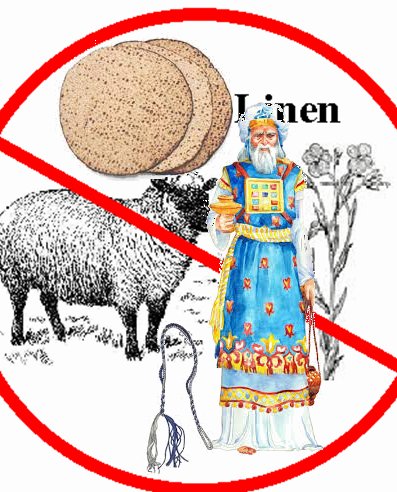
Continued from Part 2 (Pesach)
Introduction
Chag haMatzah sameach kol beit Yisra'el and Mishpachah - welcome to the first day of the Messianic Feast of Unleavened Bread in this the year of Penultimate Judgment or as I sometimes refer to it, the 'Dress Rehearsal' right before the Great Tribulation and Final Judgment at the end of the æon or age when Yah'shua the Messiah (Jesus Christ) returns for the second and last time.
The Structure of the Seven Days of Chag haMatzah
Chag haMatzah is a seven day-long celebration with the first and the last (seventh) days being qadosh (holy, set-apart) convocations, in other words, sabbaths. The first (on Aviv 15) is a regular creation-calendar sabbath, the seventh (Aviv 21) is an 'extra' one, and the day after this last or seventh day is a regular creation-calendar sabbath (Aviv 22) [1]. The intervening days are traditionally called Kol haMoed or 'weekdays of the festivals', and whilst it is true that there is no sabbath between them, on the second day of the Feast (Aviv 16) is a special feast called Yom haBikkurim (not to be confused with the similar sounding Yom haKippurim or 'Yom Kippur' for short) or Day of the Firstborn which was a type of the Resurrection Day of the Firstborn Son of Heaven.
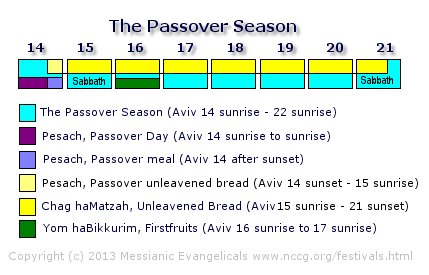
The Elements of Chag haMatzah
The basic elements of Chag haMatzah are as follows. Chametz or leaven symbolises sin. Unleavened Bread speaks of sanctification which is a process subsequent to salvation which is represented by Pesach (Passover). Sanctification, as represented by Chag haMatzah, is the act or process following salvation, which occurs when you make a conscious and deliberate choice to repent of your sins and surrender your life to Yah'shua the Messiah (Jesus Christ), which renders the believer qadosh or holy (set-apart). This is not to be confused with justification, which is a legal declaration of innocence. Yahweh told the Hebrews to cleanse all chametz (leaven) from their homes and eat only matzah or unleavened bread for seven successive days. This symbolises a life-long qodesh, holy or set-apart walk of purification with Him. Yah'shua (Jesus) is the "Bread of Life" without the leavening effect or influence of sin. Yah'shua (Jesus) was born in Bethlehem, which in Hebrew is Beit-Lechem or 'house of bread' (or 'house of flesh' in Arabic). This Feast falls on the day that Yah'shua (Jesus) was buried after His crucifixion.
The Way of the Messiah
So we are at the beginning of a sequence of historial events expressed ritualistically which are pictures of our spiritual journey in Christ which we as Messianic Evangelicals describe as 'The Way of the Messiah'. As Pesach may be likened to conception, so Chag haMatzah is like growth and purification. It is specifically about purification that I want to talk about today as it relates to this time of judgment and why that is so important.
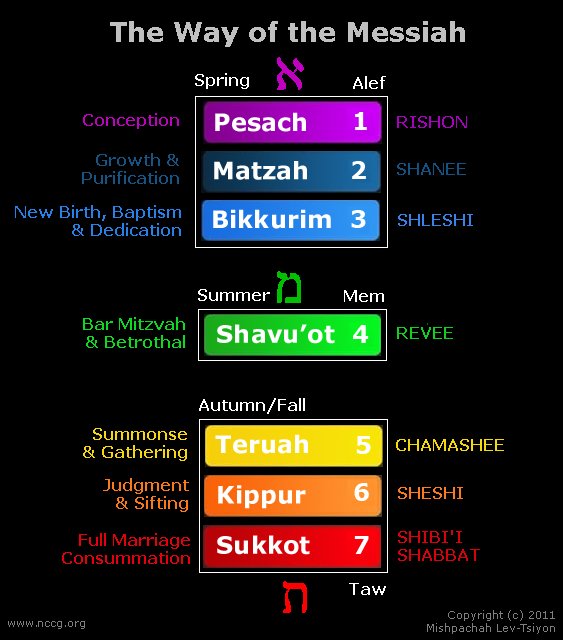
Forbidden Mixtures
The other day a brother in Germany reminded me of an aspect of the Book of Leviticus' Holiness Code of chapters 17 to 26 which I'd like to read to you.
"You shall keep My chuqqim (statutes). You shall not let your livestock breed with another kind. You shall not sow your field with mixed seed. Nor shall a garment of mixed linen and wool come upon you" (Lev.19:19, NKJV).
The Principle of Non-Mixing
To the person not acquainted with Yahweh's view of holiness this triple mitzvah (commandment) may seem a little strange at first, or at least part of it. We are only to breed our livestock animals with animals of the same kind. We are not to plant two kinds of seed in the same field. And we are not to wear clothes made of different kinds of material. Although these three items are very interesting and we could spend a whole sermon discussing each, I want to keep things as general as possible. Here Yahweh emphasises the principle of separation and distinction or non-mixing. What's interesting about this principle is that He extends it from the big things to the smallest details. No mixture of domestic animal kinds, no mixture of seed, and not even a garment may be of mixed material.
Matter/Antimatter, Nuclear and Internal Combustion
It's a bit like not mixing matter with antimatter or metalic sodium with water because the result is explosive. Those of you who are fans of the science fiction series and movies, Star Trek , will know that the imaginary warp engine propulsion of Starships is based on successfully isolating a chunk of antimatter from matter so that it doesn't touch any matter except through careful control of their interaction by which huge quantities of energy may be released. I suppose it's theoretically possible but given our poor track record in handling 'mere' nuclear power (involving the explosive 'mixing' or collision of atomic nuclei), with Chernobyl and Fukushima being the most recent disasters in Ukraine and Japan, respectively, this is probably something we should never try. So far, at any rate, such mixing would be catastrophic with only Yahweh knowing how to keep these highly reactive materials apart. As a rule, mixing is unwise until you have learned how to do it intelligently and responsibly. The internal combustion engine is an example of how we have managed to mix fuel, oxygen and sparks.
 An imaginary spaceship being propelled by carefully isolated antimatter
An imaginary spaceship being propelled by carefully isolated antimatter
Crossdressing, Mixed Vineyard Seed, Ploughing with Oxen and Donkeys
Deuteronomy 22 takes Leviticus 19 even further:
"A woman shall not wear anything that pertains to a man, nor shall a man put on a woman's garment, for all who do so are an abomination to Yahweh your Elohim (God)...You shall not sow your vineyard with different kinds of seed, lest the yield of the seed which you have sown and the fruit of your vineyard be defiled. You shall not plough with an ox and a donkey together. You shall not wear a garment of different sorts, such as wool and linen mixed together" (Dt.22:5,9-11, NKJV)
Of Separation and Cojoining
The simple, basic rule that the Creator gives is this:
- 1. What Yahweh has separated must remain separated (like the two genders); and
- 2. What Yahweh has joined together (as in a marriage covenant) must remain joined (Mt.19:6; Mk.10:7-9).
The Ban on Mixing Linen and Wool
In other words, Yahweh knows best and we must not tamper with His chukkim (statutes). There are sound reasons for them that run like a golden thread throughout the whole Creation. As we don't have time to examine all of these, let's just take the ban on mixing wool and linen. Aside from a really interesting scientific article I read some years ago about the health benefits of keeping clothing 'pure' (I am undecided about this, I have to say, as I don't know enough about it), what most don't realise - because they don't bother to study the Torah - is that Yahweh had a perfectly logical reason for this ban. Did you know that both the Levitical priestly garments and the tabernacles weavings were a combination of wool and linen? You see, the cohen's or priest's white undergarment was linen, and the brightly coloured vestment was made of wool. For this reason, those not of the priesthood were forbidden to dress in the same way. This clothes 'mix' is only for especially entrusted servants of Yahweh. 'Mixing' may only be done by the mature, the wise and, most importantly, the called. And Priesthood is not for the immature, inexperienced, untrained, uninformed and undisciplinable.
Mixing of Aromatic Spices
We see the same principle concerning the mixing of the aromatic spices required for making the anointing oil (Ex.30:33) because the distinctive fragrance would mark whatever it anointed as qadosh (holy, set-apart) for Yahweh's special purposes...and for no other. It was 'separated' from the lay-folk for a reserved purpose. That is what 'holiness' means - separated by, to, and for Yahweh, for a purpose. There is nothing random or arbitrary about it. That is why only some were allowed to accompany Moses to meet with Yahweh on Mount Sinai, but even then they could only approach so close. If they had rebelled, there would have been trouble.
Part Israelite, Part Egyptian
Again, you may ask, why the need for this really quite strict rule? Always look for the underlying spiritual reason and then ask yourself, What is the love of Elohim (God) in this, because all finally boils down or reduces to AHAVAH (LOVE). The reason Yahweh gave this ritual rule was because the Israelites were fresh from a polytheistic Egyptian world and were, in parts of themselves, still convinced in their ignorance and foolishness that their pagan gods would listen to their prayers. We know - and we shall look into this in a little more depth presently - that there was a strong urge in these spiritually 'mixed' Israelites who were still culturally Egyptian whilst being ethnically Israelite - to set up their own private shrines to offer up some extra sacrifices 'on the side' in addition to the ones Yahweh commanded. This was one reason they were forbidden to duplicate certain items used in worship such as the mixed linen and wool. (So it may have nothing to do with the scientific benefits of not mixing two different materials, though Yahweh may simultaneously have been such a genius as to know that there might be an actual health benefit to 'not mixing'. Personally I have always believed Yahweh works on multiple levels simultaneously).
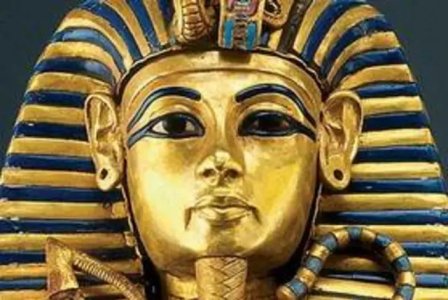 The Israelites of the First Exodus were Egyptianised culturally and religiously
The Israelites of the First Exodus were Egyptianised culturally and religiously
Divided Loyalties?
So what are you? Are you pure talmid (disciple) of Christ or have you added other, competing allegiances to form an unholy mix? I often tell Messianic Jews, to their upset, that they cannot be Messianic and Jewish any more than someone can be a 'Messianic Russian', a 'Messianic Gentile', or a 'Messianic Ugandan'. You're either Messianic - meaning, belonging to Messiah - or you're something else, because divided loyalties will always ultimately force you to make a choice. As it happens, a true Messianic is an Israelite too obeying Israel's Law or Torah - not a 'Messianic Israeli' either. The Remnant does not consist of these cliques. The Remnant is a single-headed Body, not a Hydra with many heads. And if there is one thing that Chag haMatzah shows you abundantly clearly it's this: that the Body of Christ has only one identity, and that identity is Christ.
Tzitzit, Sign of Spiritual Nobility
There's actually one biblical exception to this linen-plus-wool ban and that is in the matter of tzitzit or tassels which Israelite men under covenant were commanded to wear on the corners of their garments (Num.15:38) and still are today to remind them that they are sons of covenant. One of the strands was dyed with tekhelet, the blue dye used in the robe of the garment of the Cohen Gadol (High Priest) as well as in the tabernacle covering. You see, the wearing of tzitzit was a sign of spiritual nobility - of possessing a Shem Tov or 'good name' as a trustworthy servant of Yahweh because of his faithful commandment-keeping. The blue dye suggested priestly status. As one eminent Jewish scholar notes:
"In antiquity, the tzitzit (and the hem) was the insignia of authority, high breeding and nobility. By adding the blue woolen cord to the tzitzit, the Torah combined nobility and priesthood: Israel is not to rule man but to serve Elohim (God). Furthermore, tzitzit is not restricted to Israel's leaders, be they kings, rabbis or scholars. It is the uniform of all Israel" [2].

Sha'atnez
In the first century AD, the century of Yah'shua (Jesus) and the apostles, all of whom wore tzitzit, tzitzit were actually made from a wool-linen mixture called sha'atnez even though this violated the code of mixing the two fibres. This, however, was quite deliberate because this particular mixing, as I have already said, was exclusively for the cohenim (priests). So why were the ordinary folks permitted to wear this mixture in their own tzitzit? Because of their calling from Yahweh Himself:
"And you shall be to Me a kingdom of cohenim (priests) and a qadosh (holy) nation" (Ex.19:6, NKJV).
True Equality and Nobility
We are all called to nobility but we're not born nobles. Nobles must first become noble in character. The Kingdom of Heaven has no aristocracy - you aren't born into Priesthood spiritually-speaking, you have to grow into it. And it's open to absolutely everyone. The Prussians were the first in modern times, under Frederick the Great, to make everyone from peasant to noble, equal before the Law. But anciently, when Israel was true, is was so back then too. The Americans understood this sense of equality too, at least until very recent times, that all are born equal, having (ideally) equal opportunity, but it's always up to you what you make of your life and yourself. It's the same with sanctification which is what Chag haMatzah is all about. You either grow or you stagnate and may even fall backwards. Just because you made a decision for Christ long ago doesn't mean you are automatically in possession of a noble character or qualify for the Priesthood. You have many other choices to make first, obstacles to overcome, sins to triumph over in Messiah.
 The effect of sanctification is priesthood nobility of character
The effect of sanctification is priesthood nobility of character
Becoming a Priesthood
The goal of the believer is to be what 'mixed garments' of wool and linen represent spiritually but such are only for those who have become cohenim (priests) which was the original goal for kol Yisra'el - all Israel - but which could not be realised under the Old Covenant because of the rebellion of the Golden Calf and had to await the restoration of the higher Melchizedek Priesthood with the coming of Messiah the first time. Now all are called to wear the linen-wool priesthood garments mix but only when they have been sanctified by what Chag haMatzah stands for. As the apostle Peter said:
"But you (followers of Messiah) are a chosen generation, a Royal [Melchizedek] Priesthood, a qadosh (holy, set-apart) nation, His own special people, that you may proclaim the praises of Him who called you out of darkness into His marvelous light; who once were not a people but are now the people of Elohim (God), who had not obtained mercy but now have obtained mercy" (1 Peter 2:9-10, NKJV).
Made Kings and Priests
Remember what Yahweh said: "And you shall be to Me a kingdom of cohenim (priests) and a qadosh (holy, set-apart) nation" (Ex.19:6, NKJV). What was that nation? Israel. Did Israel ever become a nation of set-apart priests under the Old Covenant? No, because only the Levites were allowed to hold the Priesthood. So when did that prophetic promise start to be realised? Under the New Covenant of Yah'shua the Messiah (Jesus Christ), for all may now aspire to become cohenim (priests), out of every nation, kindred, and tongue but only by being grafted into Israel (Rom.11) - into Messianic Israel - which is a Kingdom of Melchizedek Cohenim (Priests) even as it is written in the Book of Revelation:
"Grace to you and peace from Him who is and who was and who is to come, and from the seven Ruachot (Spirits) who are before His throne, and from Yah'shua the Messiah (Jesus Christ), the faithful witness, the bikkur (firstborn) from the dead, and the ruler over the kings of the earth. To Him who loved us and washed us from our sins in His own blood, and has made us kings and cohenim (priests) to His Elohim (God) and Father, to Him be glory and dominion forever and ever. Amen" (Rev.1:4-6, NKJV).
The Royal Priesthood
This is a Royal Priesthood of mixed wool-and-linen tzizit-wearing kings and cohenim (priests) - those who have been sanctified through spiritual maturation and who have been purged of sin by the blood of the Passover Lamb through repentance and reformation - in short the Bride, the Remnant, the allegorcal Wife of the Faithful Witness.
The Levitical Question
If you hadn't noticed already, there is a tension here, is there not, between the faithful and the faithless, between the obedient and the disobedient, between the pure and the impure. Everyone who accepts Messiah and submits to His Kingdom rule of Torah is supposed to be a cohen (priest) but clearly is not. That is a reason we have these seven annual festivals, of which both Chag haMatzah (Unleavened Bread) and Sukkot (Tabernacles) are seven days long, to remind us that we are part of a proactive spiritual maturation process. It isn't just a question of 'being saved' and that's it (there's not such thing as 'Once Saved, Always Saved') - that's why we have seven days of Chag haMatzah to remind us of this process. Salvation isn't automatic sanctification as some denominations teach, but rather Yahweh calls the saved to sanctification, to Priesthood, and to the Bride, because there is choosing to be done. So why were only some - the Levites - set-apart from the rest in the 12 Tribes in the Old Covenant? Well, there was the historical reason, of course, namely, their loyalty to Yahweh at a time of gross apostacy in the wilderness. But Yahweh, foreknowing they would be loyal, knowing that Israel would not become a Kingdom of Cohenim (Priests) at that time, used that loyality to remind us that set-apartness or holiness requires that choices be made. The Levites, as you know from the story at Mount Sinai, refused as a whole tribe to rebel and involve themselves in the Golden Calf abominations. That is why they were chosen in the first, preparatory covenant so that they would be a picture to us of the New Covenant, showing us that there is also separation to be made in the Messianic realm, and specifically, separation from sin and lawlessness. Similar separations have always occurred within Yahweh's people following judgment in particular.
The Korahic Self-Justification for Rebellion
Consider Korah's rebellion in the wilderness and mark well the rationale he employed for his rebellion! What was his self-justification for rising up against Yahweh's navi (prophet), Moses? It's very interesting. Follow with me in Numbers 16:3 which says:
"They (the rebels led by Korah) gathered together against Moses and Aaron, and said to them, 'You take too much upon yourselves, for all the congregation is qadosh (holy, set-apart), every one of them, and Yahweh is among them. Why then do you exalt yourselves above the congregation of Yahweh?" (Num.16:3, NKJV).
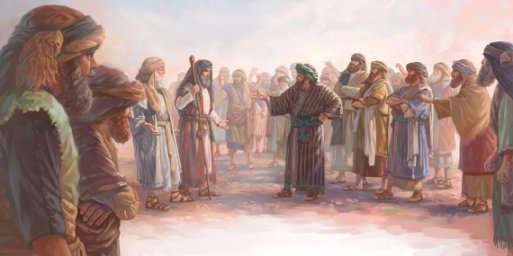 Korah and followers arguing self-righteously with Moses and Aaron
Korah and followers arguing self-righteously with Moses and Aaron
The False Sometimes Sounds Like the Truth
This is an argument from egalitarian socialism and on the surface it sounds very reasonable because looks so much like Yahweh's way. After all, Korah and the other rebels wore tzitzit like Moses, Aaron and the rest of the male members of the nation, signifying to what they had been called. You see, Korah was in effect saying: 'Look, we're all priests, we all have the same status in Yahweh's eyes, so who do you, Moses and Aaron, think you are giving us orders?'
The Third Rebellion
O the devilish deception in that man's words! There is a difference between equality of opportunity and equality of outcome, because equality of outcome can only happen as a result of the exercise of free agency operating according to divine tavnith (pattern), in other words, according to the book, which is Torah. And it's the same devilish lie we hear in so many of the churches which say we're all equal in Christ so no one should be leaders. 'We're all the same now and we'll all end up in Heaven the same too'. No we're not. 'We're all leaders now!' No we're not. 'We're all special, we're all the same'. No we're not. That depends on the character we develop in the exercise of free will. We had such a rebellion in our own community years ago which is known by us as the 'Third Rebellion'. They wanted to get rid of leaders and thought they were on to a 'higher' form of Christianity. Unrepentant sinners always try it out. In practice it never works anyway, as the early communists discovered early on when the Red Chinese abolished all ranks in the atmy. There was chaos, anyone could object to an officer's orders. The Third Rebellion quickly petered out and I think practically all of them are either atheists or agnostics now.
Yahweh Did Not Agree With the Arrogance of Korah's Egalitarianism
So does all of this sound nauseatingly familiar? Where in the secular world have you heard such sentiments? This is a fundamental denial of the authority that comes with sanctification, the reason Yahweh has inserted seven days of Chag haMatzah to remind Israel that all are called to be equal, but with equality of outcome there must first come submission, obedience, and acquiescence to Yahweh's will in the appointment of different offices according to the giftings He has given. Did Korah's argument rest well with Yahweh? Did our Heavenly Father nod in agreement with him? No sir! No ma'am! The King of the Universe was so furious that He swallowed this upstart and his followers into the ground and dragged them down to Sheol. That's what He did. Korah was every bit a part of the spirit of the age - of Satan's age, the Babylonian age of spiritual harlotry - which has been on earth since the Fall. Yes, there was, and still is, equality in and of salvation. We are all saved on the same terms. No one is 'more' qualified than another. It's a level playing field. But salvation is not sanctification because Pesach (Passover) is not Chag haMatzah (Unleavened Bread). They're separate, the one following the other. Learn from this as Yahweh intended.
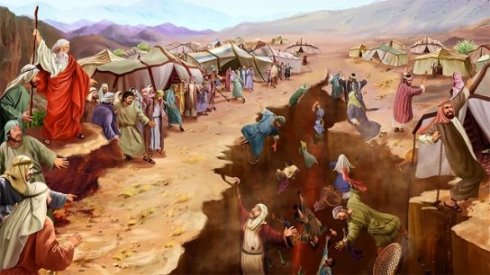 Yahweh's answer to the arrogance of rebelliousness of Korah and his men
Yahweh's answer to the arrogance of rebelliousness of Korah and his men
A Good Name and Multiple Marriage
Yahweh has set up a Kingdom Order which purposefully contains a tension which, on the one hand, says that every person is to see him- or herself called to be a representative for Yahweh. That's one end of the rope. At the other end each person must must learn to yield to the authority of priestly leadership which is gained only by divine appointment, the qualification for which is sanctification leading to qodosh (holy, sey-apart) character...what the Bible calls having a Shem Tov or 'Good Name'. The name of a person is his character in the Hebrew world of the Bible. Why do you think the seven women in Isaiah 4:1 were drawn to a single man whose name they desired? Because he had a shem, a 'name' - not his birth name but a reputation for righteousness, for nobility, for virtue, for faithfulness, for loyalty, for courage - a shem tov, a good name which the other men, to whom they were not drawn, did not. The Bible, and life itself, is a drama of contrasts between these two types of character and everything inbetween. You have to ask yourself why these women wanted what they did. On one level, this is the story of seven women seeking a joint-husband, electing to become co-wives, which is a picture of something even more elevated.
The Body or Bride of Christ
And what is that? It is, on the other hand, about the Bride of Christ - the the Messiah-adoring, Torah-obedient Remnant - desiring to be allegorically 'married' to Christ because of His good name, His shem tov, His superlative Character, His trustworthiness. Ask yourself, why are you drawn to Christ? Why do you love Him so? Why is surrendering to Him, and obeying Him, when we think of human beings, comparitively easy? Because of His flawless, sinless character. The one with a shem tov, a good name, has good character, and good character isn't something automatically acquired by making a single decision, whether it be to be saved or whether to be married, the two being directly compared with one another in Scripture. But carnal man - carnal believers specifically - don't like the idea of gradual sanctification because they don't like the idea of overcoming sin and the struggle and suffering that that implies. They want it all on a plate, like Korah, with or without acquiring good character. They want something for nothing, and those who want something for nothing tend not only to be rather immature but rather objectionable in character too. Does anyone here admire self-entitlement?
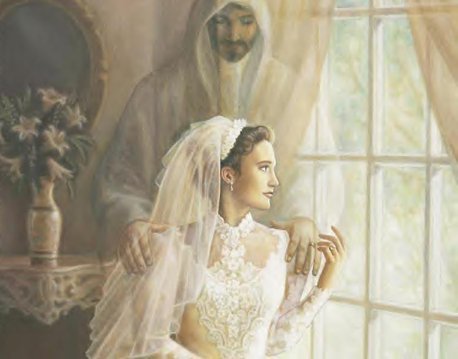 The Bride is irresistably drawn by the good character of the Bridegroom
The Bride is irresistably drawn by the good character of the Bridegroom
Another Mixture in Israel
Chag haMatzah, the Feast of Unleavened Bread, is all about what I have been talking about on an individual, personal level. The next time we discuss this festival, after the teaching on Yom haBikkurim tomorrow, we shall be looking at this on a collective, national and global level as it pertains to the Penultimate Judgment which is what the later autumn (fall) festival of Yom haKippurim or Day of Atonements is going to be all about this year. I'd like you, if you would, in the meantime, to carefully re-read the story of the Exodus because there's a 'tension' there which most people miss. There's a mixing not only of Israelite blood and Egyptian culture, but something much more 'in your face' that explains some of the apparent anomalies in the story. To give you a clue, I want you to find out how the Golden Calf was made...or to be more exact, who made it. Because there were some people in Israel who had a destabilising and destructive influence on the nation, just as today there are some people in the Messianic Community or Church having the same disasterous effect in the Body of Christ.
Conclusion
Tomorrow, on the second day of Chag haMatzah, we shall also and primarily be assembling to celebrate Yom haBikkurim, for there are two feasts-in-one, and purposefully so. Until then, Yahweh bless you and fill you with His wonder. Amen.
Continued in Part 4 (Yom haBikkurim)
Endnotes
[1] For a prophetic explanation of these back-to-back sabbaths, see The Double Sabbath Explained
[2] Jacob Milgrom, Sitting at the Feet of Rabbi Jesus (Jewish Publication Society), p.203
Acknowledgements
[1] Lois Tverberg, What's So Wrong With Mixing Wool and Linen?
Comments from Readers
[1] "WOW! What an amazing. sinsightful teaching" (MW, USA, 10 April 2021)
For more information about Chag haMatzah,
visit the Chag haMatzah/Passover website:



V260
|


